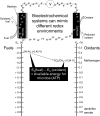Microbial fuel cells and microbial ecology: applications in ruminant health and production research
- PMID: 20024685
- PMCID: PMC2855437
- DOI: 10.1007/s00248-009-9623-8
Microbial fuel cells and microbial ecology: applications in ruminant health and production research
Abstract
Microbial fuel cell (MFC) systems employ the catalytic activity of microbes to produce electricity from the oxidation of organic, and in some cases inorganic, substrates. MFC systems have been primarily explored for their use in bioremediation and bioenergy applications; however, these systems also offer a unique strategy for the cultivation of synergistic microbial communities. It has been hypothesized that the mechanism(s) of microbial electron transfer that enable electricity production in MFCs may be a cooperative strategy within mixed microbial consortia that is associated with, or is an alternative to, interspecies hydrogen (H(2)) transfer. Microbial fermentation processes and methanogenesis in ruminant animals are highly dependent on the consumption and production of H(2)in the rumen. Given the crucial role that H(2) plays in ruminant digestion, it is desirable to understand the microbial relationships that control H(2) partial pressures within the rumen; MFCs may serve as unique tools for studying this complex ecological system. Further, MFC systems offer a novel approach to studying biofilms that form under different redox conditions and may be applied to achieve a greater understanding of how microbial biofilms impact animal health. Here, we present a brief summary of the efforts made towards understanding rumen microbial ecology, microbial biofilms related to animal health, and how MFCs may be further applied in ruminant research.
Figures





Similar articles
-
Electrochemical performance and microbial community profiles in microbial fuel cells in relation to electron transfer mechanisms.BMC Microbiol. 2017 Oct 18;17(1):208. doi: 10.1186/s12866-017-1115-2. BMC Microbiol. 2017. PMID: 29047333 Free PMC article.
-
Dynamic role of single-celled fungi in ruminal microbial ecology and activities.J Appl Microbiol. 2020 Apr;128(4):950-965. doi: 10.1111/jam.14427. Epub 2019 Oct 13. J Appl Microbiol. 2020. PMID: 31463982 Review.
-
RUMINANT NUTRITION SYMPOSIUM: Use of genomics and transcriptomics to identify strategies to lower ruminal methanogenesis.J Anim Sci. 2015 Apr;93(4):1431-49. doi: 10.2527/jas.2014-8329. J Anim Sci. 2015. PMID: 26020166
-
Microbial fuel cells and microbial electrolysis cells for the production of bioelectricity and biomaterials.Environ Technol. 2013 Jul-Aug;34(13-16):1915-28. doi: 10.1080/09593330.2013.813951. Environ Technol. 2013. PMID: 24350445
-
Microbial fuel cell (MFC) power performance improvement through enhanced microbial electrogenicity.Biotechnol Adv. 2018 Jul-Aug;36(4):1316-1327. doi: 10.1016/j.biotechadv.2018.04.010. Epub 2018 May 3. Biotechnol Adv. 2018. PMID: 29729376 Review.
Cited by
-
Kluyvera georgiana MCC 3673: A Novel Electrogen Enriched in Microbial Fuel Cell Fed with Oilseed Cake.Curr Microbiol. 2019 May;76(5):650-657. doi: 10.1007/s00284-019-01673-0. Epub 2019 Apr 2. Curr Microbiol. 2019. PMID: 30941539
-
Microbial community in microbial fuel cell (MFC) medium and effluent enriched with purple photosynthetic bacterium (Rhodopseudomonas sp.).AMB Express. 2014 Apr 1;4:22. doi: 10.1186/s13568-014-0022-2. eCollection 2014. AMB Express. 2014. PMID: 24949257 Free PMC article.
-
Exploring the Rumen and Cecum Microbial Community from Fetus to Adulthood in Goat.Animals (Basel). 2020 Sep 11;10(9):1639. doi: 10.3390/ani10091639. Animals (Basel). 2020. PMID: 32932976 Free PMC article.
-
Comparative analysis of microbial profiles in cow rumen fed with different dietary fiber by tagged 16S rRNA gene pyrosequencing.Curr Microbiol. 2013 Aug;67(2):130-7. doi: 10.1007/s00284-013-0336-3. Epub 2013 Mar 8. Curr Microbiol. 2013. PMID: 23471692
-
Recent nutritional strategies and feed additives to stimulate proper rumen development in young goats.Transl Anim Sci. 2025 Mar 8;9:txae164. doi: 10.1093/tas/txae164. eCollection 2025. Transl Anim Sci. 2025. PMID: 40191692 Free PMC article.
References
-
- Griffin D. Economic impact associated with respiratory disease in beef cattle. Vet Clin North Am Food Anim Pract. 1997;13:367–377. - PubMed
-
- Aelterman P, Rabaey K, De Schamphelaire L, Clauwaert P, Boon N, Verstraete W. Microbial fuel cells as an engineered ecosystem. In: Wall JD, Harwood CS, Demain AL, editors. Bioenergy. Washington, DC: ASM; 2008.
-
- Rismani-Yazdi H, Christy AD, Dehority BA, Morrison M, Yu Z, Tuovinen OH. Electricity generation from cellulose by rumen microorganisms in microbial fuel cells. Biotechnol Bioeng. 2007;97:1398–1407. - PubMed
-
- Schröder U. Anodic electron transfer mechanisms in microbial fuel cells and their energy efficiency. Phys Chem Chem Phys. 2007;9:2619–2629. - PubMed
-
- Aelterman P, Freguia S, Keller J, Verstraete W, Rabaey K. The anode potential regulates bacterial activity in microbial fuel cells. Appl Microbiol Biotechnol. 2008;78:409–418. - PubMed
Publication types
MeSH terms
Substances
LinkOut - more resources
Full Text Sources

